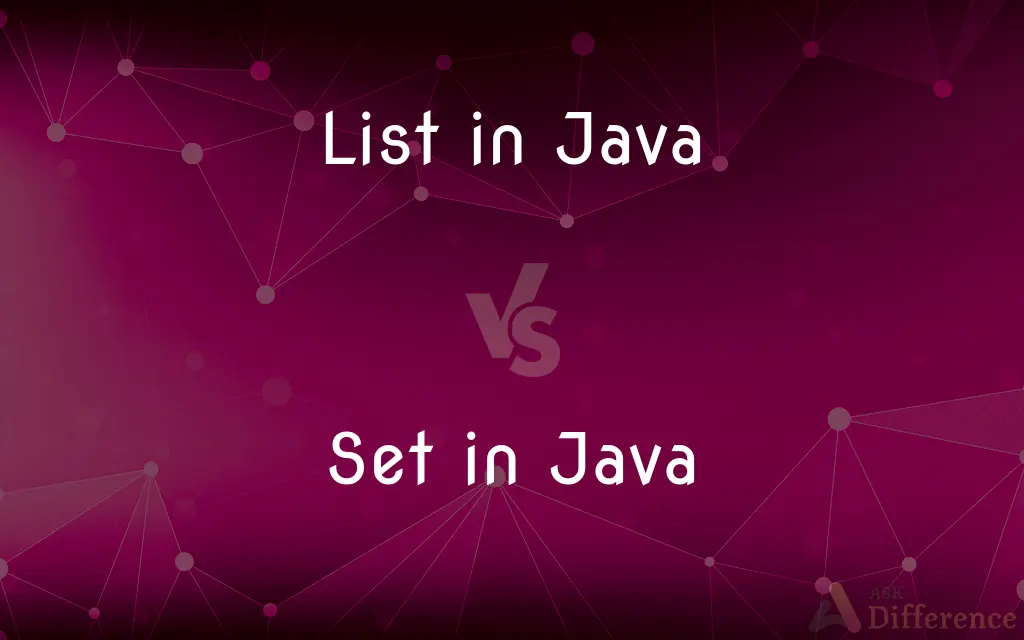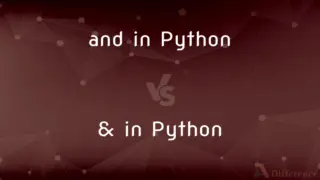List in Java vs. Set in Java — What's the Difference?
By Tayyaba Rehman — Published on January 4, 2024
List in Java is an ordered collection allowing duplicates, accessed by indices. Set in Java is an unordered collection containing unique elements, denying duplicates.

Difference Between List in Java and Set in Java
Table of Contents
ADVERTISEMENT
Key Differences
In Java, a List represents an ordered collection allowing duplicate elements, enabling access via indices. Lists, like ArrayList and LinkedList, maintain insertion order and accommodate repetitive entries.
Contrarily, a Set in Java signifies an unordered collection prohibiting duplicate elements. Sets, including HashSet and TreeSet, prioritize uniqueness, making them ideal for distinct element storage and operations like union and intersection.
Lists, being ordered, facilitate sequential access, allowing modifications like adding, removing, and accessing elements via indices. Iterating through Lists maintains the insertion sequence.
Sets, being unordered, focus on uniqueness, disregarding duplicates, ensuring that each element appears only once within the collection. They facilitate operations like intersection, union, and difference between sets.
Lists support duplicates, allowing multiple occurrences of the same element, while preserving the insertion order, enabling retrieval based on the index.
ADVERTISEMENT
Contrarily, Sets disallow duplicates, ensuring uniqueness, which impacts operations relying on distinct elements, such as set arithmetic or eliminating repetitions.
Java Lists utilize implementations like ArrayList and LinkedList, enabling diverse manipulations suited for scenarios requiring ordered collections with possible duplications.
Sets, utilizing implementations like HashSet and TreeSet, emphasize uniqueness, beneficial for scenarios demanding distinct elements and efficient search operations.
Lists, with ordered elements, are suitable for scenarios prioritizing sequence and allowing repetitive entries, aiding in scenarios requiring indexing and duplicate retention.
Sets, emphasizing uniqueness and disallowing duplicates, are beneficial for scenarios demanding exclusive elements, like maintaining unique collections or applying mathematical set operations.
Comparison Chart
Order
Maintains insertion order allowing duplicates
Unordered collection disallowing duplicates
Element Access
Accessed by indices, supports duplicates
Unique elements, no duplicates allowed
Collection Type
Suitable for ordered, indexed collections
Ideal for distinct elements, mathematical sets
Implementations
Includes ArrayList, LinkedList
Includes HashSet, TreeSet
Iteration
Maintains insertion sequence during iteration
No defined order during iteration
Compare with Definitions
List in Java
Represents an ordered collection allowing duplicates.
ArrayList in Java is a List allowing duplicate elements, maintaining insertion order.
Set in Java
Disallows duplicates, ensuring every element is distinct.
Set in Java like TreeSet prohibits duplicate entries, maintaining only unique elements.
List in Java
Facilitates access via indices, supporting sequential operations.
LinkedList, a List in Java, permits index-based access for inserting and retrieving elements.
Set in Java
Prioritizes uniqueness for efficient search and mathematical operations.
Sets like HashSet in Java are optimal for exclusive elements, facilitating set operations.
List in Java
Supports duplicate entries while preserving their order.
In a List like ArrayList, duplicate elements can exist while retaining their insertion sequence.
Set in Java
Utilizes implementations such as HashSet and TreeSet.
Java's TreeSet, a Set implementation, arranges elements in a sorted order.
List in Java
Enables ordered collections suited for scenarios requiring sequence.
Java Lists like LinkedList maintain the order of elements, vital for sequential operations.
Set in Java
Supports mathematical set operations like union and intersection.
Using Sets in Java, one can perform set operations like union or intersection efficiently.
List in Java
Utilizes implementations for diverse manipulations like ArrayList.
ArrayList, a List in Java, allows various operations suitable for ordered collections.
Set in Java
Represents an unordered collection containing unique elements.
HashSet in Java is a Set ensuring unique elements without any specific order.
Common Curiosities
How does the order of elements affect List operations?
The order in Lists matters for operations like retrieval by index, iteration, and maintaining the sequence of elements.
Which List implementation is better for frequent insertions and deletions?
LinkedList in Java is more suitable for frequent insertions and deletions due to its efficient node-based structure.
Is it possible to convert a Set to an array in Java?
Yes, using the toArray() method, a Set in Java can be converted into an array.
How can you check if a List contains a specific element?
The List method contains() is used to check if a List contains a particular element, returning a boolean value based on its existence.
What happens when trying to add a duplicate element to a Set?
In a Set, adding a duplicate element will be ignored, as Sets only allow unique elements.
What advantages does a List offer over an array?
Lists in Java provide dynamic resizing, support for generics, and various methods for manipulation compared to arrays, which have a fixed size.
Can elements in a Set be sorted automatically?
TreeSet in Java automatically sorts its elements upon insertion, maintaining them in a sorted order.
Can a Set contain null values in Java?
Yes, a Set in Java can contain one null value since it permits only unique elements, including one null entry.
How does a List differ from an array in Java?
A List is a dynamic, resizable collection that can hold duplicates and provides various manipulation methods, while arrays have fixed sizes and static structures.
What's the impact of removing an element in a List on its size?
Removing an element from a List decreases its size by one, as Lists dynamically adjust their size upon element removal.
Can a Set store elements in a specific order based on insertion?
No, Sets in Java don’t preserve the order of insertion; they maintain their elements in an unordered fashion.
Can a Set guarantee the order of its elements?
No, Sets in Java do not guarantee a specific order for their elements; they are unordered collections.
How does a Set handle equality checks between objects?
Sets in Java use the equals() and hashCode() methods to determine the equality of objects to avoid storing duplicates.
How does a List differ from a Queue in Java?
A List in Java allows elements to be accessed by index and permits duplicates, whereas a Queue focuses on the FIFO (First-In-First-Out) order and doesn't allow duplicates.
Which List implementation is more suitable for search operations?
ArrayList in Java is more efficient for search operations as it uses indices for access, allowing faster retrieval compared to LinkedList.
Share Your Discovery

Previous Comparison
Modern Literature vs. Contemporary Literature
Next Comparison
and in Python vs. & in PythonAuthor Spotlight
Written by
Tayyaba RehmanTayyaba Rehman is a distinguished writer, currently serving as a primary contributor to askdifference.com. As a researcher in semantics and etymology, Tayyaba's passion for the complexity of languages and their distinctions has found a perfect home on the platform. Tayyaba delves into the intricacies of language, distinguishing between commonly confused words and phrases, thereby providing clarity for readers worldwide.
















































